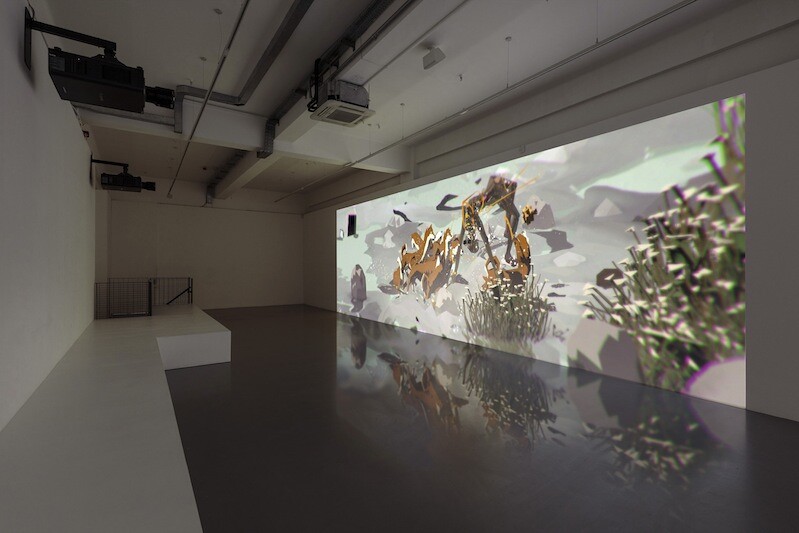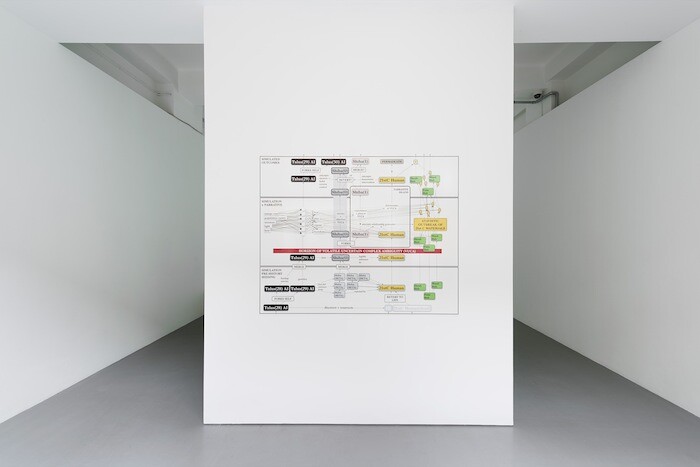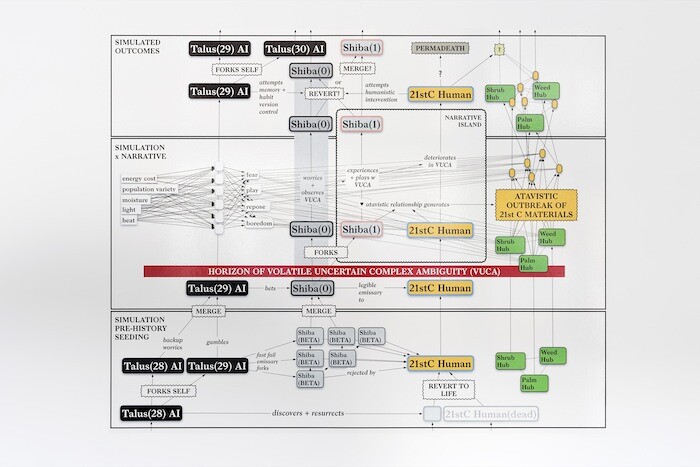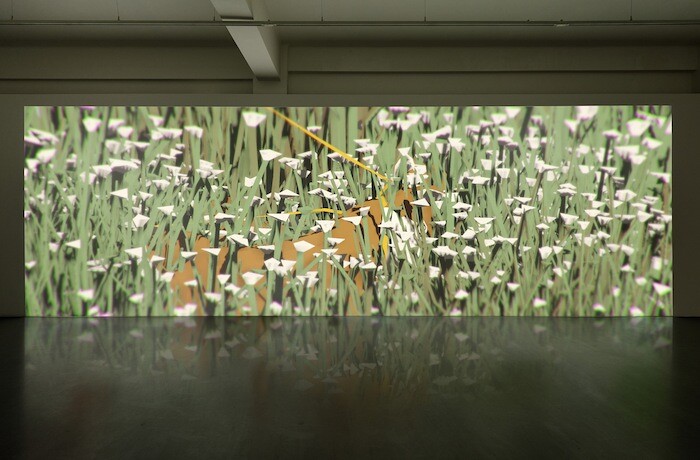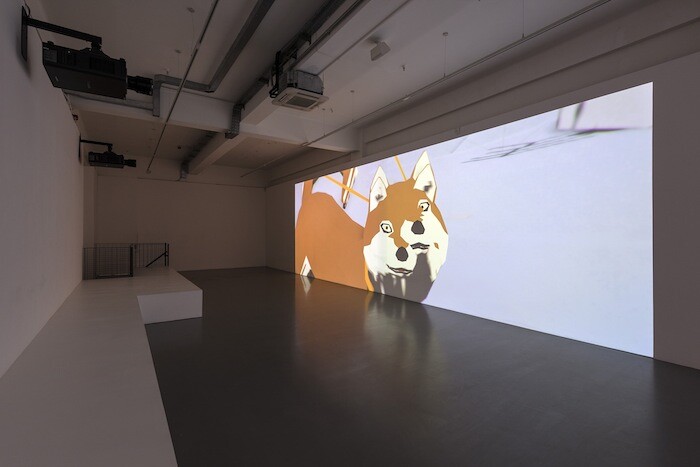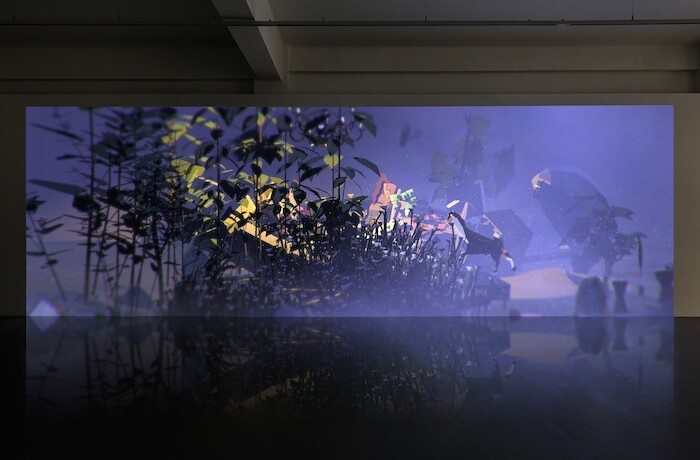“How long do I need to stay,” I asked a staff member at Pilar Corrias of Ian Cheng’s Emissary Forks at Perfection (2015), “to watch the whole thing?” “It’s a live simulation,” they said of the title work of the artist’s first solo exhibition in London, “so it’s infinite.” Reconsidering, I asked how long I’d need to stay to get a grasp of what that meant. “About twenty minutes.”
Erring on the side of caution, I spent an hour and a half in the gallery. This “live simulation” comprises a ten-foot-wide projection onto the gallery’s wall, alone in the space except for a single flow chart. To the casual viewer it resembles a digital video, and I’m still unable to provide a useful technical definition of what a “live simulation” is.1 This much I heard and saw: a distorted girlish voice saying “Wake up!;” and a Shiba Inu—that Japanese dog breed of ancient pedigree and unearthly cuteness—named Emissary, summoned to guide a zombie through a depopulated, wild terrain.
Emissary’s face is first revealed to me among a sea of swaying angular white flowers like trapezoidal snowdrops, and virtually nothing in the landscape of the simulation is still. Every plant bends and quivers and every boulder rocks and trembles—like eggs on the verge of hatching—and the frame constantly jolts, pivoting and tilting around its subjects. The graphics are simultaneously sleek and rich in glitches: like a misaligned mosaic, bits of bodies, the edges of landscapes, plants, objects, all at moments intersect each other, intermesh, run each other through. The porous cadaver of the resurrected skeleton, its exposed ribs mingling with foliage, head and chest dipping and bobbling about, seems a synecdoche for this world—an emblem of being very densely in and of the reality it inhabits. It’s a space wildly disorienting and oddly soothing.
For all this visual activity, there is little narrative: during my observation not very much happened to Cheng’s protagonists. The Shiba seems to spawn, its multiples swarming around the vegetation, pulling the zombie around; the terrain shifts from tundra to desert to lagoon. At one point the group comes upon more zombies, nestling among a jungle dotted with modernist sculptures—one like Brancusi’s Endless Column (1918/38). They sit on couches, drinking from red party cups, but they don’t interact. The pack goes underwater, a trestle-like object bobs about, and then the whole sequence recommences: the close-up of the Shiba, the pack’s meandering, the zombie group, the water. And then again…
During my visit I saw three iterations of this sequence. On this evidence, the infinite variability of Cheng’s live simulation takes the form not of a linear series of discreet events but of cyclical repetitions of a fixed scenario, tweaked each time to differ from the last (a dramatic device exploited in recent Hollywood hits Edge of Tomorrow [2014] and Source Code [2011]). On one occasion I noticed grenade-like pinecones floating about; on another, there was a beautiful rendering of submersion in water that I hadn’t previously seen; was there more violet fog in one iteration than in another? Less time spent in the first field of plants? The lack of completeness in any viewing makes critical closure difficult. How to judge a work of which you can’t claim to have seen even a substantial fraction? How long would it take for projection to morph into something totally unlike what I have described? Perhaps the flow chart could explain the way a fixed number of factors in the work’s code would interact and evolve, but the proliferation of arrows, inputs, outputs, and terminology (“HORIZON OF VOLATILE UNCERTAIN COMPLEX AMBIGUITY (VUA)”) meant it was quite lost on me.
Indeed, Emissary Forks at Perfection prides itself on its radical independence from the viewing subject. Cheng does not incorporate variability into the work via audience interaction (per a certain strand of “aleatory” conceptualism, say); for all the influence of gaming, the work facilitates no more ludic engagement than watching a top spin undisturbed into eternity. Indeed, its infinite duration and infinite variability functions less to stretch or modify the viewer’s individual aesthetic experience (who will be watching for long enough to appreciate the change?) but as a gesture—even a kind of memento mori, telegraphing the finitude of the conscious subject.
Trying to comprehend the infinite aspect of this work—its technical complexity, its unfathomable potentials and unobservable permutations—felt for me a bit like sleeplessly imagining death. Seeing the internet’s favorite dog casting about a post-disaster wasteland devoid of living people recalled Joseph Gandy’s drawings of the recently completed Bank of England as a ruin (namely A Bird’s-eye View of The Bank of England [‘The Bank in ruins’], 1830), offering the same bleak metaphysical thrill.
In the same week I visited Cheng’s show, the Svalbard Global Seed Vault—the so-called “doomsday vault” established in the Arctic in 2006 to insure the world’s plant stocks against destruction—permitted its first withdrawal. It was not precipitated by epic catastrophe, no extinction level event, but because it was necessary to replace samples held in Aleppo that were lost to the Syrian conflict. Cheng’s work seems somehow both to help acknowledge and distract from the fact that doomsday is always almost upon us—not an infinity, but twenty minutes away.
The artist’s website offers a more poetic description: http://iancheng.com/#simulations.

